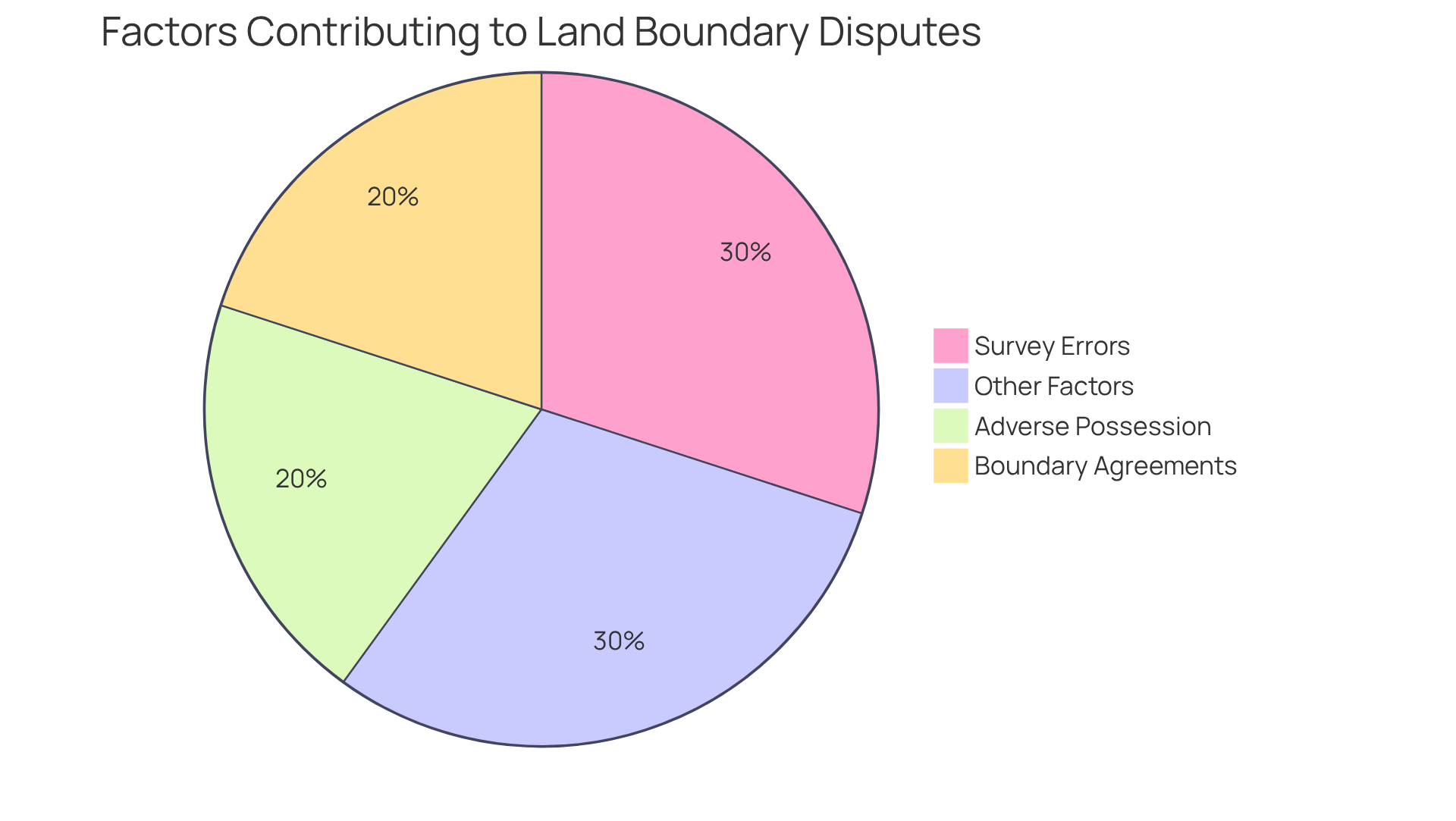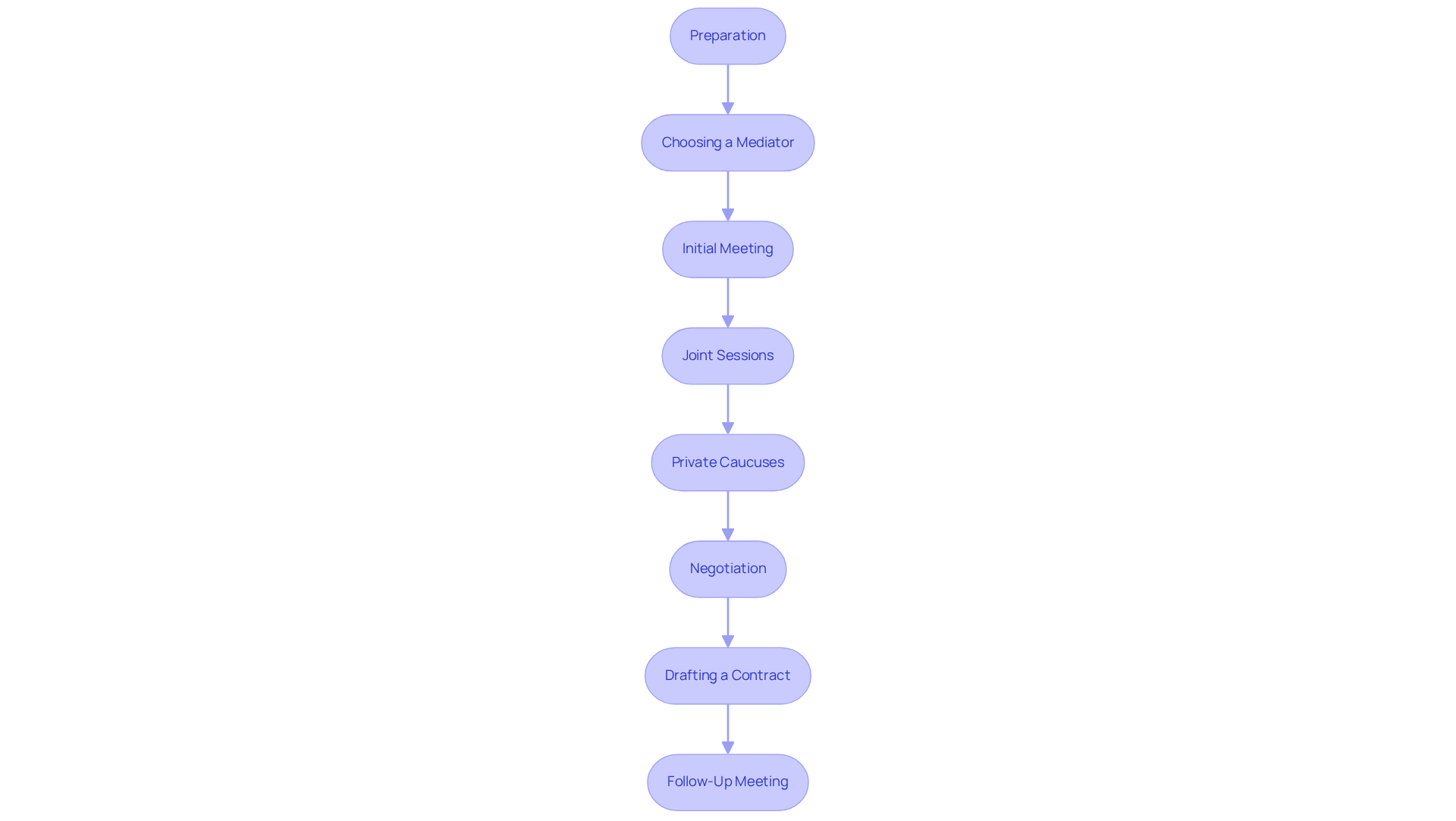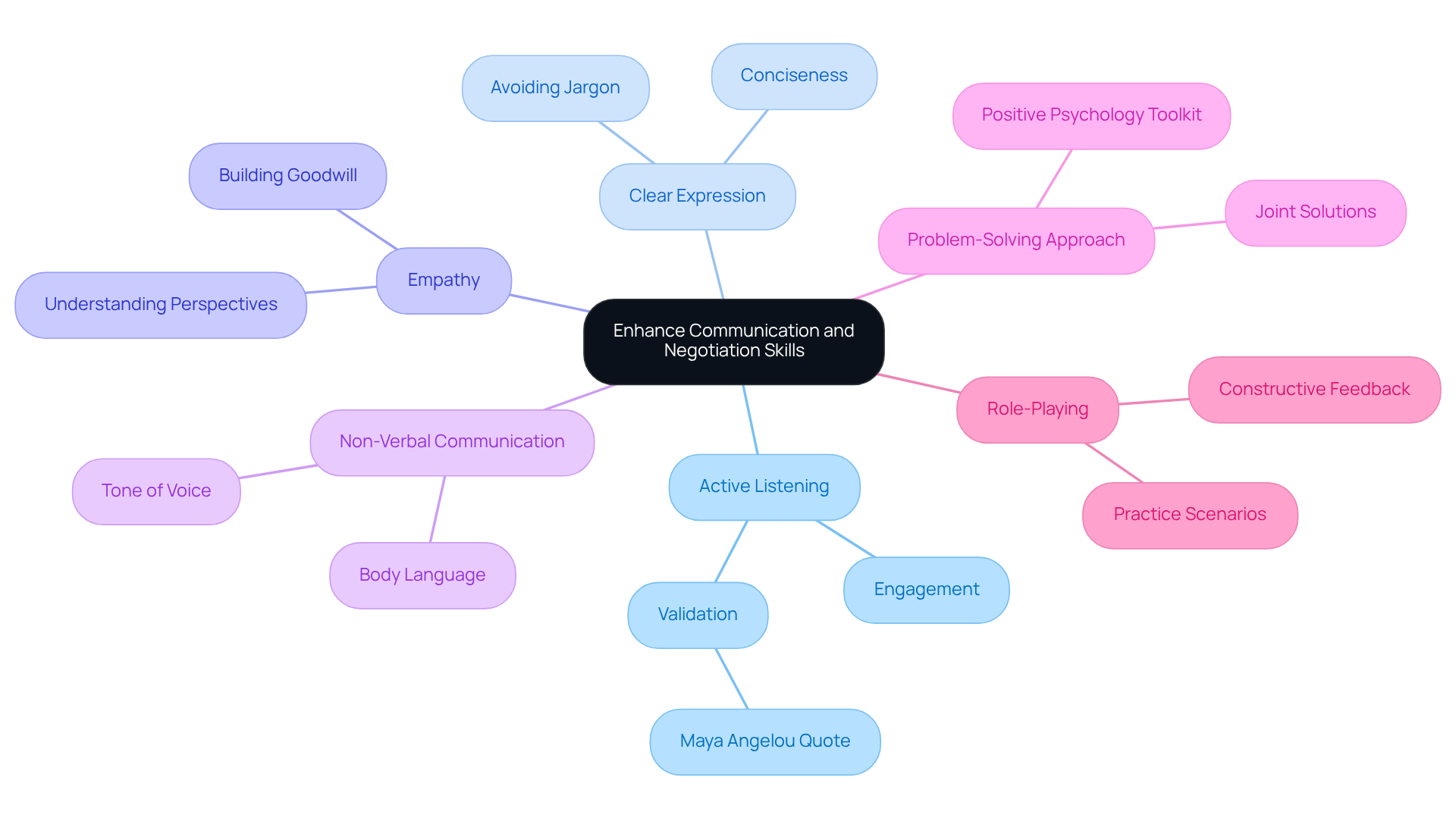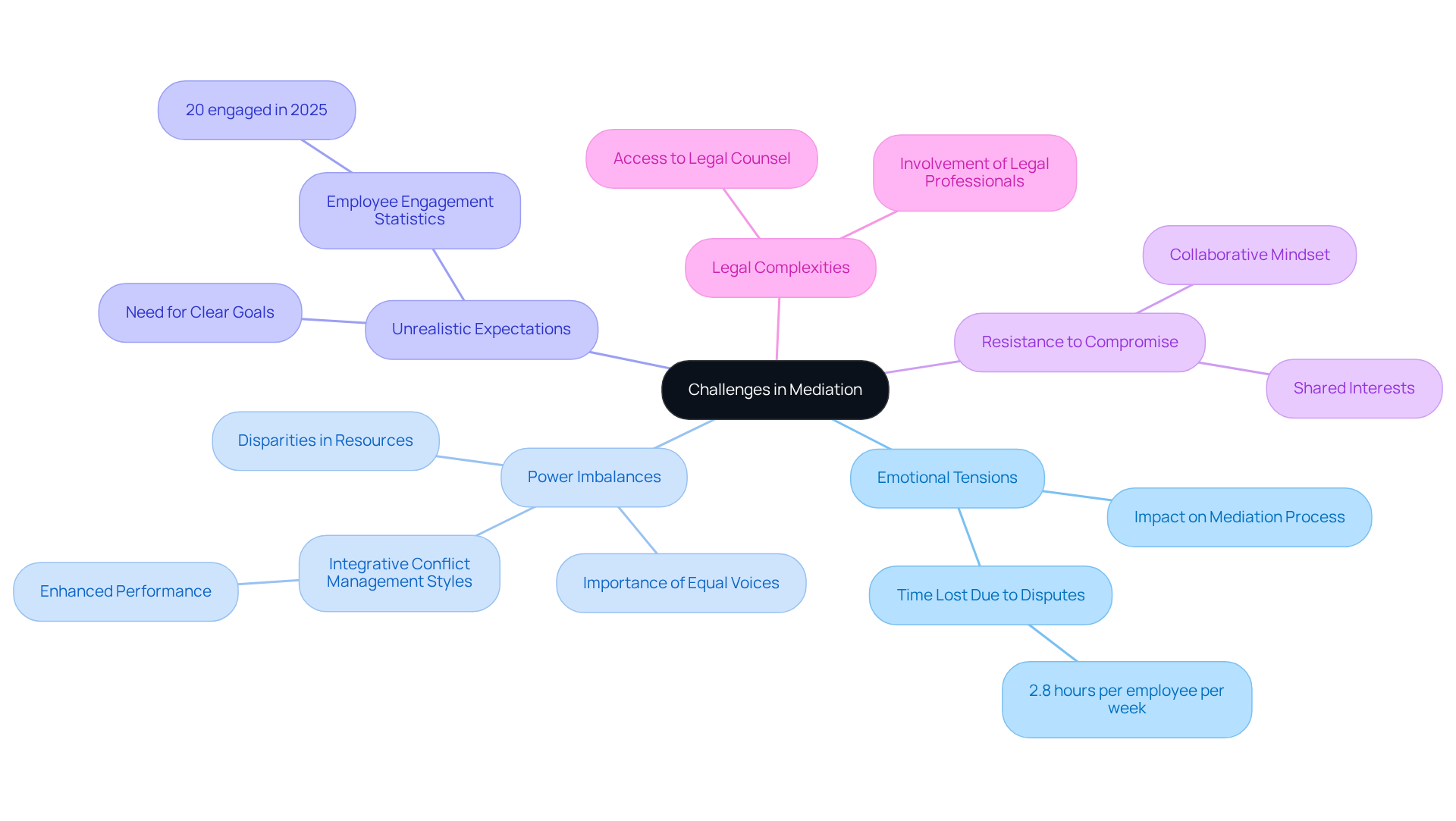Overview
Land boundary dispute mediation is a structured process designed to resolve conflicts stemming from ambiguous property lines, survey errors, and historical claims among various stakeholders. The complexities of land acquisition often involve legal and regulatory challenges that can exacerbate these disputes.
Key steps in mediation include:
- Preparation
- Selecting a neutral mediator
- Fostering open communication
However, emotional tensions and power imbalances may hinder effective resolution. Understanding these challenges is crucial for stakeholders seeking resolution. By addressing these issues through mediation, parties can achieve a more amicable and efficient outcome.
Introduction
Navigating the intricate world of land boundary disputes presents a formidable challenge, akin to walking a tightrope. With tensions running high and stakes even higher, these conflicts arise from unclear property lines, historical claims, or survey inaccuracies. They not only disrupt relationships among stakeholders but can also lead to costly legal battles.
This article explores essential steps for effective mediation, providing insights into how parties can convert conflict into collaboration. Yet, what occurs when emotional tensions, power imbalances, and unrealistic expectations threaten to derail the resolution process? Examining these challenges unveils the keys to cultivating a successful mediation environment.
Understand Land Boundary Disputes
Land boundary dispute mediation often addresses issues that arise from ambiguous property lines, conflicting surveys, or historical claims, involving various stakeholders such as landowners, developers, and municipalities. A comprehensive understanding of legal definitions concerning property boundaries, local zoning regulations, and easement implications is essential for effective negotiation. Key factors contributing to these disputes include:
- Survey Errors: Approximately 30% of land disputes stem from inaccuracies in land surveys, leading to confusion over property lines.
- Adverse Possession: This legal principle allows individuals to claim ownership of land they have occupied for a specified duration without the owner's consent, complicating boundary issues.
- Boundary Agreements: Prior agreements regarding property lines may lack proper documentation, resulting in misunderstandings.
By recognizing these elements, including the legal definitions outlined in Chapter 177 of the Florida Statutes, you can approach land boundary dispute mediation with a well-informed perspective, facilitating a more effective resolution.

Follow the Mediation Process Steps
The mediation process for land boundary disputes unfolds through several essential steps that can significantly enhance resolution outcomes:
-
Preparation is crucial. Collect all pertinent documents, such as surveys, title deeds, and any prior agreements. Understanding the interests and viewpoints of all participants is vital. As Greg Parent, a respected facilitator, underscores, "My mission in every mediation is to be beneficial to the individuals involved," highlighting the importance of comprehensive preparation.
-
Choosing a mediator is the next step. Select a neutral third-party mediator who is experienced in land boundary dispute mediation. Their expertise is essential in facilitating discussions and directing groups toward a resolution. Notably, mediation rates for a two-person case are approximately $600.00 per individual per hour, making it a cost-effective alternative to arbitration.
-
The initial meeting sets the stage. Conduct this meeting where each side presents their viewpoint, establishing a foundation for open communication and mutual understanding.
-
Joint sessions are integral. Participate in these sessions where all participants can share their concerns and interests. The facilitator will guide the discussion to ensure productivity and focus.
-
Private caucuses may follow. The facilitator may conduct private sessions with each party to delve deeper into their positions and explore potential compromises.
-
Negotiation aims for a mutually acceptable solution. The facilitator assists in recognizing shared interests and enabling discussions to reconcile differences. Greg Parent observes, "Some of my utility comes from my extensive experience, having practiced law for over 25 years," emphasizing the importance of seasoned professionals in this phase.
-
Once a conclusion is reached, drafting a contract becomes essential. The mediator will assist in creating a written contract that specifies the conditions, which all participants must sign to formalize the conclusion.
-
Finally, arrange a follow-up meeting. This ensures adherence to the agreement and addresses any outstanding issues, reinforcing the commitment to the solution.
By adhering to these steps, parties can navigate the complexities of land boundary dispute mediation more effectively, fostering a collaborative environment that promotes resolution. Incorporating insights from seasoned negotiators and pertinent statistics can further enhance the resolution process.

Enhance Communication and Negotiation Skills
To enhance communication and negotiation skills during mediation, consider the following strategies:
- Active Listening: Engage in active listening by fully concentrating on the speaker, acknowledging their points, and responding thoughtfully. As Maya Angelou noted, "People will forget what you said, people will forget what you did, but people will never forget how you made them feel." This technique not only validates the speaker's feelings but also fosters a deeper connection, which is crucial in negotiations.
- Clear Expression: Clearly articulate your thoughts in a concise manner. Avoid using jargon that may confuse other parties, ensuring that your message is easily understood.
- Empathy: Demonstrate empathy towards the concerns of others. Understanding their perspective can build goodwill and facilitate compromise, making it easier to reach a resolution. Experts emphasize that modeling empathetic behavior is crucial for effective communication.
- Non-Verbal Communication: Pay attention to body language and tone of voice, as these elements significantly influence the atmosphere of the discussion. Positive non-verbal cues can enhance trust and openness, reinforcing the importance of emotional regulation in communication.
- Problem-Solving Approach: Adopt a problem-solving mindset that focuses on finding solutions rather than assigning blame. This joint approach encourages all participants to work together towards a shared objective, as highlighted in the Positive Psychology Toolkit©, which contains over 500 science-based exercises to enhance interpersonal skills.
- Role-Playing: Engage in role-playing scenarios with a colleague to practice negotiation techniques. This method allows for constructive feedback and helps refine your skills in a safe environment. Case studies, such as "Building Strong Social-Emotional Skills," illustrate the effectiveness of such strategies in real-world applications.

Address Challenges in Mediation
Mediation in land boundary disputes frequently encounters a range of challenges that can impede effective resolution.
-
Emotional Tensions: Disputes often elicit strong emotions, which can disrupt the mediation process. Recognizing these emotions and allowing individuals to express them is crucial for maintaining focus and facilitating resolution. According to CPP Global, workplace disputes and personality clashes consume approximately 2.8 hours of work time per employee each week, underscoring the necessity of addressing emotional tensions.
-
Power Imbalances: Disparities in power or resources can skew negotiations, leaving one party feeling marginalized. Mediators must ensure that all voices are heard equally, creating an environment where each participant feels valued. A study published in the International Journal of Research in Education and Science highlights that integrative conflict management styles enhance performance, indicating that addressing power imbalances can yield better outcomes.
-
Unrealistic Expectations: Parties may approach negotiations with expectations that lack grounding in reality. Establishing clear, achievable goals from the outset can help manage these expectations and steer the discussion productively. In 2025, only 20% of employees reported feeling engaged with their work, revealing that unrealistic expectations can contribute to disengagement.
-
Resistance to Compromise: Some individuals may hesitate to make concessions. Promoting a collaborative mindset by emphasizing shared interests rather than rigid positions can help dismantle barriers to agreement. The Peaceful Leaders Academy asserts that cultivating a collaborative work environment is vital for effective conflict resolution.
-
Legal Complexities: The legal dimensions of disputes can be intimidating for participants. Ensuring that all stakeholders have access to legal counsel and considering the involvement of legal professionals in the mediation process can alleviate concerns and clarify issues. A case study on effective conflict management in manufacturing demonstrates how addressing legal complexities can lead to improved outcomes.
By proactively tackling these challenges, mediators in land boundary dispute mediation can create a more conducive environment for resolution, ultimately resulting in more satisfactory outcomes for all parties involved.

Conclusion
Navigating land boundary disputes is a complex and challenging endeavor; however, understanding the mediation process is essential for achieving effective resolutions. Recognizing the unique factors that contribute to these disputes—such as survey errors and adverse possession—enables stakeholders to prepare for mediation and engage in informed discussions. The outlined steps—thorough preparation, selecting an experienced mediator, fostering open communication, and drafting a clear agreement—serve as a roadmap to navigate these intricate situations.
Key insights emphasize the importance of enhancing communication and negotiation skills to facilitate a successful mediation process. Techniques such as active listening, empathy, and a collaborative mindset significantly improve interactions among parties. Addressing challenges like emotional tensions and power imbalances ensures that all voices are heard. By proactively tackling these obstacles, mediators can create a supportive environment conducive to resolution.
Ultimately, effective land boundary dispute mediation transcends resolving specific conflicts; it represents a commitment to fostering understanding and cooperation among all parties involved. As individuals engage in this process, they are encouraged to adopt a problem-solving approach and remain open to compromise, paving the way for sustainable solutions. Embracing these principles not only aids in resolving current disputes but also contributes to a culture of collaboration and respect in future interactions.
Frequently Asked Questions
What are land boundary disputes?
Land boundary disputes are conflicts that arise from ambiguous property lines, conflicting surveys, or historical claims between various stakeholders such as landowners, developers, and municipalities.
What are common causes of land boundary disputes?
Common causes include survey errors, adverse possession claims, and boundary agreements that lack proper documentation.
How significant are survey errors in land boundary disputes?
Survey errors account for approximately 30% of land disputes, leading to confusion over property lines.
What is adverse possession?
Adverse possession is a legal principle that allows individuals to claim ownership of land they have occupied for a specified duration without the owner's consent, complicating boundary issues.
Why are boundary agreements important in land disputes?
Boundary agreements are important because prior agreements regarding property lines may lack proper documentation, which can lead to misunderstandings between parties.
How can understanding legal definitions help in land boundary disputes?
A comprehensive understanding of legal definitions concerning property boundaries, local zoning regulations, and easement implications is essential for effective negotiation and resolution of disputes.
Where can one find legal definitions related to land boundaries?
Legal definitions concerning land boundaries can be found in Chapter 177 of the Florida Statutes.
List of Sources
- Understand Land Boundary Disputes
-
Statutes & Constitution :View Statutes :
Online Sunshine (https://leg.state.fl.us/statutes/index.cfm?App_mode=Display_Statute&URL=0100-0199/0177/0177.html)
- Follow the Mediation Process Steps
- Mediation To Raise The Spirit (https://mediate.com/mediation-to-raise-the-spirit)
- Why Even a Failed Mediation is Beneficial - Annette Burns (https://heyannette.com/why-even-a-failed-mediation-is-beneficial)
- Greg Parent - Miles Mediation & Arbitration (https://milesmediation.com/neutrals/gregory-j-parent-esq)
- Dispute Resolution Quotes - ADR Toolbox (https://adrtoolbox.com/library/adr-quotes)
- Enhance Communication and Negotiation Skills
- How to Improve Your Empathic Listening Skills: 7 Techniques (https://positivepsychology.com/empathic-listening)
- 10 Quotes (and Tips) for Building Strong Social-Emotional Skills - Brookes Blog (https://blog.brookespublishing.com/10-quotes-and-tips-for-building-strong-social-emotional-skills)
- 32 Phrases To Help You Express Empathy - The Conflict Expert (https://the-conflictexpert.com/2019/08/06/32-phrases-to-help-you-express-empathy)
- Address Challenges in Mediation
- Workplace Conflict Statistics in 2025 | Peaceful Leaders Academy (https://peacefulleadersacademy.com/blog/workplace-conflict-statistics)
- Dispute Resolution Services Statistics | FINRA.org (https://finra.org/arbitration-mediation/dispute-resolution-services-statistics)
- Workplace Conflict Statistics | Pollack Peacebuilding Systems (https://pollackpeacebuilding.com/workplace-conflict-statistics)




